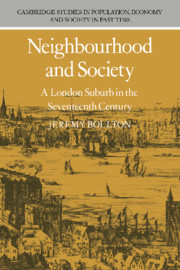Book contents
- Frontmatter
- Contents
- List of figures
- List of tables
- Preface
- Abbreviations
- 1 Introduction
- 2 The demographic background
- 3 Earning a living in early seventeenth-century Southwark
- 4 Wealth and social structure
- 5 Household structure and the household economy
- 6 Power, status and social mobility
- 7 Residential patterns and property ownership
- 8 The dynamics of a local community
- 9 Social relationships in the urban neighbourhood
- 10 The institutional structure of the neighbourhood
- 11 Conclusion: neighbourhood and society in seventeenth-century London
- Bibliography
- Index
- Frontmatter
- Contents
- List of figures
- List of tables
- Preface
- Abbreviations
- 1 Introduction
- 2 The demographic background
- 3 Earning a living in early seventeenth-century Southwark
- 4 Wealth and social structure
- 5 Household structure and the household economy
- 6 Power, status and social mobility
- 7 Residential patterns and property ownership
- 8 The dynamics of a local community
- 9 Social relationships in the urban neighbourhood
- 10 The institutional structure of the neighbourhood
- 11 Conclusion: neighbourhood and society in seventeenth-century London
- Bibliography
- Index
Summary
London in the seventeenth century: an agent of social change?
During the sixteenth and seventeenth centuries London became the largest city in Europe. In terms of size the capital moved progressively up the European urban hierarchy from a position of perhaps seventh or eighth biggest in 1550 to third in 1600 (exceeded by Paris and Naples) and second in 1650 (behind Paris). By 1700 London was, and throughout the eighteenth century remained, the largest European city. The capital's growth in the seventeenth century was mainly responsible for the doubling of that proportion of England's population living in urban settlements of 10,000 or more at a time when the rest of Europe experienced stagnation in this respect. After 1700 London's share of, and contribution to, the unique urbanisation experienced by England between 1600 and 1800 declined. In eighteenth-century England the proportion of the nation's population living in towns of 10,000 or more again nearly doubled, reaching 24% by 1800. London's share of this population, however, declined from 86% in 1700 to 66% in 1750 and only 46 % by the end of the century. In the context of European urbanisation the growth of England's capital city was most striking in the seventeenth century.
The importance of London's rapid population growth and its effects on the economy of sixteenth- and seventeenth-century England are now well established.
- Type
- Chapter
- Information
- Publisher: Cambridge University PressPrint publication year: 1987

